The global macroalgae market is valued at USD 10 billion in 2025 and is expected to reach USD 21 billion by 2035, reflecting a CAGR of 7.7%. Factors driving this growth include the rising demand for plant-based nutrition, expanding applications in pharmaceuticals and cosmetics, and increasing awareness of environmental sustainability.
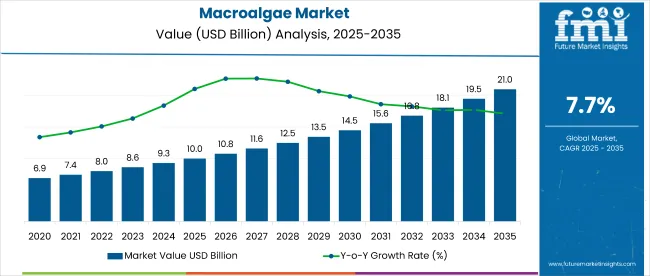
| Metric | Value |
|---|---|
| Estimated Size (2025E) | USD 10 billion |
| Projected Value (2035F) | USD 21 billion |
| CAGR (2025-2035) | 7.7% |
Moreover, macroalgae’s role in climate change mitigation, through carbon capture and marine cultivation, is contributing to the market's expansion. The incorporation of macroalgae into food products due to their nutritional profile is further enhancing global demand.
North America is expected to account for the largest share of the market, with the USA projected to grow at a CAGR of 9.9%. Meanwhile, Japan is also anticipated to register rapid growth with a CAGR of 7.6% followed by Germany at 6.1% CAGR. Red macroalgae is likely to dominate by type, commanding over 42% of the market due to its high nutritional content and versatility. The food and beverage segment will remain the leading application area, accounting for 47% of the market share in 2025.
The market holds significant shares across its parent markets due to its versatile applications. It accounts for around 45% of the overall seaweed market, driven by its dominance in red, brown, and green algae categories. Within the broader algae market, macroalgae contributes nearly 35%, as the remainder include microalgae used in biofuels and pigments.
In the marine ingredients market, it captures about 30%, while representing 20% of the plant-based ingredients market. Additionally, macroalgae comprises roughly 15% of both the functional food ingredients and nutraceutical ingredients markets, reflecting its emerging role in health supplements and fortified food products.
Going forward, market growth is expected to be influenced by advances in seaweed farming technologies and processing innovations, such as cell wall disruption techniques to increase bioavailability. Government incentives promoting marine cultivation for climate mitigation are being introduced in regions like South Korea and the European Union.
Additionally, companies are investing in sustainable packaging and functional macroalgae-based product lines, including snacks, skincare, and dietary supplements, to diversify their portfolios and appeal to health-conscious consumers.
The market is segmented by type, application, and region. Based on type, the market is segmented into red macroalgae, green macroalgae, and brown macroalgae. By application, the market includes food & beverages, agriculture, pharmaceuticals, cosmetics & personal care, and others (animal feed, textiles, and biofuel production). Regionally, the market is classified into North America, Latin America, Europe, East Asia, South Asia, Oceania, and the Middle East & Africa.
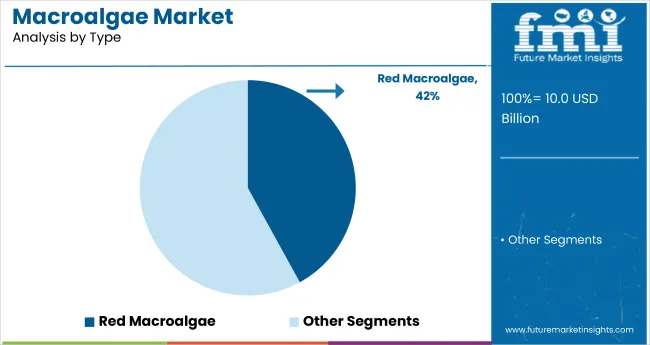
Red macroalgae is projected to remain the most lucrative sub-segment under the type category, holding a 42% market share in 2025. Due to its high content of protein, vitamins, and antioxidants, red macroalgae is increasingly used in both the food and pharmaceutical industries. It is especially favored in Asian cuisine and health-focused supplements. Its ability to be processed into carrageenan, a key hydrocolloid, is also driving demand in the food additive sector.
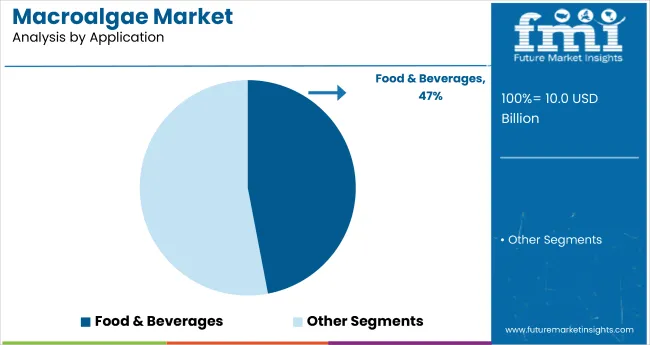
The food and beverages segment is projected to lead the application category, accounting for 47% of the global market share in 2025. This dominance is driven by the rising demand for plant-based, nutrient-rich, and low-calorie food products, prompting manufacturers to incorporate macroalgae into a wide range of products such as snacks, beverages, soups, and meat substitutes. Furthermore, the growing popularity of veganism and the increasing use of seaweed-based functional ingredients are accelerating macroalgae adoption, particularly across Western markets.
Recent Trends in the Macroalgae Market
Challenges in the Macroalgae Market
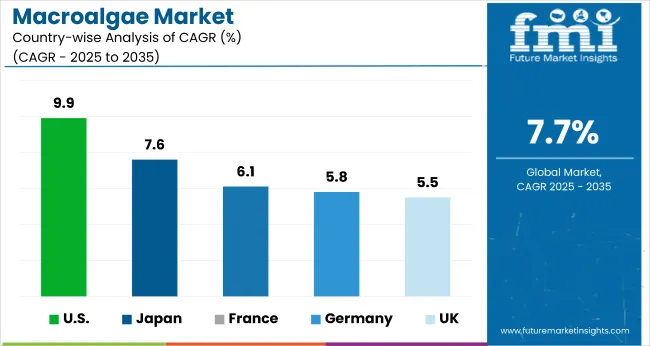
Among the top five countries in the global market, the USA is projected to witness the fastest growth, registering a strong CAGR of 9.9% from 2025 to 2035. This robust expansion is primarily driven by increasing applications of macroalgae in nutraceuticals, functional foods, and emerging carbon-capture technologies. Growing investments in seaweed farming and sustainability-focused R&D are also supporting long-term market growth.
Japan follows closely with a CAGR of 7.6%, backed by its long-standing culinary tradition of seaweed consumption and the integration of smart aquaculture systems. France and Germany are projected to register moderate growth at 6.1% and 5.8% respectively, owing to growing consumer awareness of marine-based wellness products, along with rising adoption of algae-derived materials for sustainable packaging. The UK, with a 5.5% CAGR, is seeing increasing demand for sustainable beauty, food supplements, and eco-conscious consumer goods.
The report covers an in-depth analysis of 40+ countries; five top-performing OECD countries are highlighted below.

The USA macroalgae market is projected to grow at a robust CAGR of 9.9% from 2025 to 2035, driven by increased usage in nutraceuticals, skincare, and plant-based product lines. Regulatory endorsement of seaweed-based carbon capture and rising venture capital inflows in algae technology are strengthening commercialization.
While early growth (2020 to 2024) was moderate, the next decade promises aggressive scaling across sectors such as bioplastics, wellness, and vegan nutrition. Industrial diversification and environmental policy support continue to differentiate USA macroalgae expansion.
Macroalgae demand in the UK is forecast to grow at a CAGR of 5.5% from 2025 to 2035, driven by sustainability-focused consumer preferences and support for eco-conscious farming. Earlier growth was steady, with notable traction in food and cosmetic applications.
The upcoming decade will witness an increased uptake of red and brown macroalgae in soups, snacks, and skincare due to organic label popularity. Ongoing R&D in algae-derived green chemistry and plant biostimulants enhances long-term demand visibility.
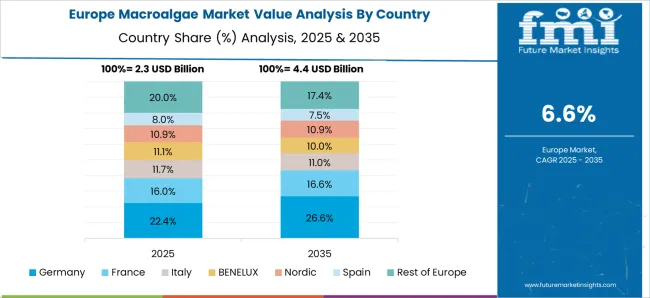
Macroalgae market in Germany is expected to grow at a 5.8% CAGR from 2025 to 2035, gaining pace through expanding demand for ocean-derived ingredients in cosmetics and supplements. Growth from 2020 to 2024 was modest due to limited consumer exposure, but algae-based biopackaging and wellness innovation are lifting market dynamics. Government-led support for algae biorefineries and eco-label product preferences will underpin future growth.
The macroalgae market in France is projected to expand at a CAGR of 6.1% between 2025 and 2035, powered by consumer affinity for marine-origin beauty and culinary innovation. From 2020 to 2024, growth was modest, driven by luxury skincare and fine-dining use. Looking forward, food-grade red macroalgae is expected to remain popular in gastronomy, while marine sustainability efforts will create a regulatory boost for local harvesting.
The Japan macroalgae market is forecast to grow at a 7.6% CAGR from 2025 to 2035, supported by its strong culinary heritage and rising functional food innovation. Growth from 2020 to 2024 was high, aided by the popularity of traditional algae types like nori, kombu, and wakame. The aging population’s health concerns and high-tech aquaculture methods are further expanding applications. Japan aims to enhance sustainability and export competitiveness through smart farming.
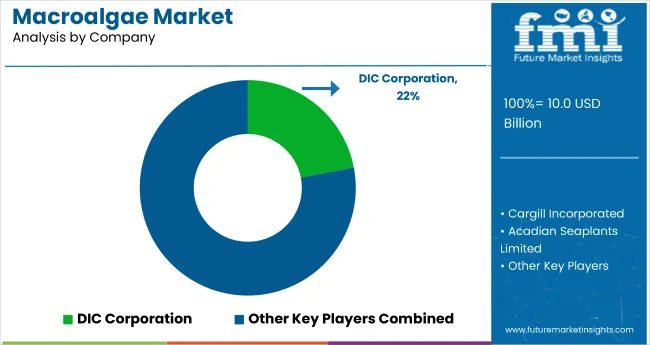
The global market is fragmented, with a mix of multinational corporations and regionally focused players competing on product innovation, sustainable harvesting, and multi-industry applications. Major companies such as Cargill, DIC Corporation, Acadian Seaplants Limited, and CP Kelco hold significant market share, while niche players like Irish Seaweeds and Mara Seaweed specialize in artisanal and localized offerings.
Top suppliers are actively pursuing strategies involving organic farming, clean-label product development, and marine biotechnologies. Many companies are aligning sustainability goals through regenerative ocean practices, while others are enhancing processing technologies for higher purity and nutritional retention.
Strategic partnerships, capacity expansions, and certifications such as USDA Organic or EU COSMOS are being prioritized. Innovation in seaweed-derived texturizers, gelling agents, and bioactives is also intensifying competition. Some players, like DIC Corporation, are advancing in the algae-based pigment space, while others, like CP Kelco, are broadening application scopes in food hydrocolloids and personal care.
| Report Attributes | Details |
|---|---|
| Current Total Market Size (2025) | USD 10 billion |
| Projected Market Size (2035) | USD 21 billion |
| CAGR (2025 to 2035) | 7.7% |
| Base Year for Estimation | 2024 |
| Historical Period | 2020 to 2024 |
| Projections Period | 2025 to 2035 |
| Market Analysis Parameters | Revenue in USD billion / Volume in kilotons |
| By Type | Red Macroalgae, Green Macroalgae, Brown Macroalgae |
| By Application | Food & Beverages, Agriculture, Pharmaceuticals, Cosmetics & Personal Care, Others (Animal Feed, Textiles, Biofuel) |
| Regions Covered | North America, Latin America, Europe, Middle East & Africa, East Asia, South Asia, Oceania |
| Countries Covered | United States, Canada, United Kingdom, Germany, France, China, Japan, South Korea, Brazil, Australia and 40+ countries |
| Key Players | DIC Corporation, Cargill, Incorporated, Acadian Seaplants Limited, CP Kelco, Dow Chemical Company, E. I. du Pont de Nemours and Company, Gelymar SA, Irish Seaweeds, Marcel Trading Corporation, Qingdao Gather Great Ocean Algae Industry Group (GGOG), Seasol International Pty Ltd, Yan Cheng Hairui Food Co., Ltd., Ocean Harvest Technology Limited, Mara Seaweed, and Algatechnologies |
| Additional Attributes | Dollar sales by value, market share analysis by segments, and country-wise analysis |
The global macroalgae market is estimated to be valued at USD 10.0 billion in 2025.
The market size for the macroalgae market is projected to reach USD 20.3 billion by 2035.
The macroalgae market is expected to grow at a 7.4% CAGR between 2025 and 2035.
The key product types in macroalgae market are red macroalgae, green macroalgae and brown macroalgae.
In terms of application, food & beverages segment to command 52.6% share in the macroalgae market in 2025.






Our Research Products

The "Full Research Suite" delivers actionable market intel, deep dives on markets or technologies, so clients act faster, cut risk, and unlock growth.

The Leaderboard benchmarks and ranks top vendors, classifying them as Established Leaders, Leading Challengers, or Disruptors & Challengers.

Locates where complements amplify value and substitutes erode it, forecasting net impact by horizon

We deliver granular, decision-grade intel: market sizing, 5-year forecasts, pricing, adoption, usage, revenue, and operational KPIs—plus competitor tracking, regulation, and value chains—across 60 countries broadly.

Spot the shifts before they hit your P&L. We track inflection points, adoption curves, pricing moves, and ecosystem plays to show where demand is heading, why it is changing, and what to do next across high-growth markets and disruptive tech

Real-time reads of user behavior. We track shifting priorities, perceptions of today’s and next-gen services, and provider experience, then pace how fast tech moves from trial to adoption, blending buyer, consumer, and channel inputs with social signals (#WhySwitch, #UX).

Partner with our analyst team to build a custom report designed around your business priorities. From analysing market trends to assessing competitors or crafting bespoke datasets, we tailor insights to your needs.
Supplier Intelligence
Discovery & Profiling
Capacity & Footprint
Performance & Risk
Compliance & Governance
Commercial Readiness
Who Supplies Whom
Scorecards & Shortlists
Playbooks & Docs
Category Intelligence
Definition & Scope
Demand & Use Cases
Cost Drivers
Market Structure
Supply Chain Map
Trade & Policy
Operating Norms
Deliverables
Buyer Intelligence
Account Basics
Spend & Scope
Procurement Model
Vendor Requirements
Terms & Policies
Entry Strategy
Pain Points & Triggers
Outputs
Pricing Analysis
Benchmarks
Trends
Should-Cost
Indexation
Landed Cost
Commercial Terms
Deliverables
Brand Analysis
Positioning & Value Prop
Share & Presence
Customer Evidence
Go-to-Market
Digital & Reputation
Compliance & Trust
KPIs & Gaps
Outputs
Full Research Suite comprises of:
Market outlook & trends analysis
Interviews & case studies
Strategic recommendations
Vendor profiles & capabilities analysis
5-year forecasts
8 regions and 60+ country-level data splits
Market segment data splits
12 months of continuous data updates
DELIVERED AS:
PDF EXCEL ONLINE

Thank you!
You will receive an email from our Business Development Manager. Please be sure to check your SPAM/JUNK folder too.
Chat With
MaRIA